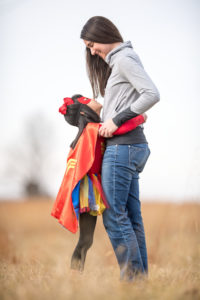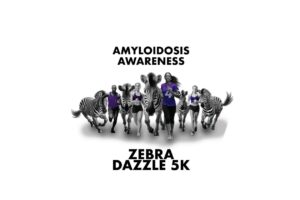
On Oct. 1, 2016, seven-year-old Lily Rancourt wore her Wonder Woman costume and brand new red sneakers with “hero” and “heart” on the tongues. With her family and friends, she braved cold and rain to toe the starting line for the Race for Every Child 5k in D.C.
At Lily’s urging, “We Don’t Miss a Beat” became the largest team at the race, and along the way, team members raised more than $18,000 for the Cardiology and Heart Fund at Children’s National Medical Center, making it one of the top fundraising teams, too.
The Rancourt family finished together in 1:04:48. Lily spent the entire race dashing ahead of her siblings, then waiting for them to catch up, offering encouragement.
Lily inspired and motivated an entire team to join her that gray October day and raised money for children to receive treatment for all types of cardiovascular problems. But Lily Rancourt isn’t just a big-hearted little girl. Behind the hero logo across Lily’s chest that day hid another heroic mark, a scar left when Lily received her own heart transplant one month before her fifth birthday. Since then, the first grader has regained her health and achieved her dream of running and playing with her siblings.
Taking Risks
Lily was born July 22, 2009 in inner Mongolia with a congenital heart defect. She lived in an orphanage and underwent two open-heart surgeries before doctors deemed her terminal and declined further treatment. She held on as family after family reviewed her adoption file and chose not to bring her home with them. She seemed like too big of a risk.
“I just could not get her off my heart. I kept feeling that if nobody goes for this little girl, then she’s going to die an orphan because they’re saying that she’s terminal and there’s nothing that could help her,” she remembered. Jacques hesitated. Four children, one of them critically ill, seemed overwhelming to a young family. Emily asked him to pray about it.
“I really think this is our daughter,” she told him.
After being adopted, Lily began a difficult course of medical exams and treatment. Doctors at Children’s National Medical Center found that Lily’s major organs were all mirrored from their usual positions in the body, complicating any surgeries. Her right pulmonary artery no longer pumped blood to her right lung. With one lung out of commission, the real danger came from a heart that was only half-formed and could not move enough oxygen-rich blood to help Lily grow, run or play like other four-year-olds. Her doctors performed two more open-heart surgeries, and Lily and her mother spent the better part of two years living in the hospital as the girl clung to life. At each phase, the family wondered if Lily would be strong enough to survive the next surgery or even the next day.
Congenital heart disease is the most common birth defect in children, so the team at Children’s knows typical patterns and expected outcomes for most of the children it sees. In Lily’s weakened state, with just one lung and extensive scar tissue from her previous surgeries, she would be an extremely risky transplant. Doctors across the region declined three times to place her on the heart transplant list, reminding Emily that donated organs are rare. She recalled them saying: “‘we need to make sure that the recipient of these organs is as healthy as possible so that this donation can actually make a difference in a life.”
Dr. Janet Scheel had recently been hired to rebuild the center for Heart Failure and Cardiac Transplant at Children’s, so she felt particularly cautious.
“At first I told the family she might be too high-risk to do there at Children’s. Then of course her personality made me relent and take the risk and I’m glad I did,” she said.
Early on June 14, 2014, Lily’s transplant began, and her new heart was in place less than 12 hours later.
Long before the transplant, playing with her sisters often ended with Lily blue-lipped and struggling to breathe. After, she was breathing with one lung and on oxygen. Her muscles had atrophied over months in the hospital, so she traveled to and from physical therapy in a stroller. Though weak, she remained hopeful. When she saw posters promoting the Race for Every Child, they inspired her.
“Any time anybody would ask her, ‘What are you going to do when you’re out of the hospital?’ she would always tell them, ‘When I’m better and I’m out of the hospital, I’m going to run,’” her mother remembers.
It became her mantra: I want to run.
Farther Than That
“Why do we call it your hero’s heart?” Emily asked Lily.

“Because it’s a hero?” Lily tried.
“Because a hero gave it to you,” Emily reminded her, and Lily nodded solemnly.
The Rancourts don’t know much about their donor yet. There was a car crash and the victim’s lungs could not be donated, so Lily received their heart and pulmonary arteries. Doctors had hoped to restore blood flow to her right lung but were unsuccessful. The family does know that the surgery was difficult — it lasted most of the day and Lily went into cardiac arrest several times.
Recovery was no easier. Lily took 26 medications per day under the watch of a nurse. Doctors thought she might need her supplemental oxygen tank for the rest of her life. Her healthy heart struggled to adjust to her single lung and she remained frail and vulnerable.
At this point, stressed and exhausted, Emily started running. Her own mother began running marathons at age 60 and encouraged her daughter to try it as a form of self-care. In those quiet moments, Emily found her own love of running, and when she came home, she could expect Lily and her nurse to be cheering her on from the driveway.
With Lily still ailing, Emily began to wonder if the girl would ever be able to run and play. Lily’s medical team encouraged Emily to start Lily off like any beginner — see how far she could go, and the next time, try to go just a little farther.
So Emily brought Lily’s portable oxygen tank outside and the two ran to the next house on their street, a distance of about 200 feet. Within a few days, Lily was running a few houses, and then Emily was bringing a stroller along so that Lily could take breaks as they ran longer and longer distances.
About a year after the transplant, at a follow-up appointment, Lowell Frank, a runner and one of Lily’s cardiologists in her long history with Children’s, suggested that she run the 100-yard dash at the Race for Every Child. Emily remembers Lily asking how far that was. When Dr. Frank showed her, the girl was unimpressed.
“I can run way farther than that,” she told him.
“In hindsight, that was probably a big insult, huh?” said Frank, laughing as he heard the story. With the approval of Scheel, they agreed that Lily should try the 5k distance. In October of 2015, Lily donned a Supergirl costume and lined up with just her mother, after bad weather rescheduled the race. Emily carried her oxygen tank and pushed a stroller so the girl could take breaks. Just 15 months after her transplant, Lily finished the race by running into Dr. Frank’s arms for a hug.
By 2016, Lily needed neither the oxygen nor the stroller to complete the race, which is fortunate because Lily’s brother Thaddaeus has been undergoing procedures for his own open-heart surgeries and, potentially, his own heart transplant, and he rode alongside his sisters. When he’s ready, Lily is keen to help coach Thad in his recovery and running. But she’s going to start with her mother, who is nervous to jump from the 10-mile distance to a half-marathon.
“I have to teach her!” Lily gushes. “I’ll get a whistle and I’ll blow it and then she will have to run! Around the cones! Until I say stop, I say stop and I blow the whistle.”
Then she’ll help Thad in his recovery, because she remembers her own sadness at not being able to play. Then she’ll coach her sister Mackenzie hardest of all, making her do “jumping laps.”
“It’s like a jumping jack run all around the cones and it’s going to get harder and harder for her. And she’s gonna think, ‘I can’t do it!’” said Lily, who, as you can see, doesn’t exactly traffic in self-doubt.
Princess on the Run
On a snowy Saturday morning, Emily and I asked Lily how running makes her feel.
“Happy!” she cried, leaning towards me and grinning from ear to ear with the checkerboard smile of a child well-known to the Tooth Fairy.
She added, “It makes me have a lot of energy.” When she runs, she can feel her heart beating in her chest and feel grateful that she’s no longer in the hospital.
“We always said that Lily looks like Snow White,” Emily said. “We put a red bow in her hair and she looks like Snow White. And so we have a lot of pictures of her in the hospital in her little red bow.”
Lily has more in common with Snow White than the fair skin and black bob. She is warm, generous and giggles infectiously. In the Disney film, Snow White’s jealous stepmother orders a hunter to kill the girl and cut out her heart; unlike Snow White, Lily’s heart surgery was wanted and ended happily. Lily plans to dress as Disney’s version of the princess for the 2017 Race for Every Child but she prefers the Snow White depicted in her favorite book, Princesses on the Run by Smiljana Coh.
Lily started clapping excitedly as she described the book. In the story, princesses run away from their castles to escape the idleness of royal life. When they return home, they change their habits to become happier. Rapunzel gets a bob so she can exercise comfortably, Lily remembered. “Sleeping Beauty was doing yoga and Snow White was still running.”
“Snow White was pretty much the one convincing everyone to keep running. She never stopped,” Emily explained. “We said, that’s just like Lily! She was always encouraging her sisters to keep running during the race and just like Snow White, who never stopped running.”
The Girl on the Posters
A new heart can transform a child’s life, and Lily’s doctors want their patients to have full, unlimited childhoods after these difficult procedures.
“Patients like Lily, who were born with congenital heart disease … often haven’t been as active simply because they don’t have the stamina,” Scheel said. The parents, she said, become accustomed to having a sick child, “and I come along and say, ‘Okay, they can go to school. They can go to gym.’ They look at me like I’m crazy.” But according to Frank, very few heart transplant recipients need to restrict their activities afterwards.
“I’m typically optimistic and I counsel parents all the time that, you know, your kid’s a normal kid, they could be a normal kid. Seeing Lily able to do that is really gratifying,” he said.
At the hospital, Lily used to see posters promoting the Race for Every Child and dream of running. Now, she’s the one on the posters, beaming with every inch of her being, superhero logo on her chest, cape billowing behind her. Another child, perhaps sleeping in Lily’s old bed, can draw strength from this girl who has been through so much.
This story was originally published in the Spring 2017 issue of RunWashington
Recent Stories
Looking for our race calendar? Click here Submit races here or shop local for running gear
Zebra Dazzle 5k Walk/Run or 100 Bike over 30 Days
Join the Zebras for this Zebra Dazzle event for all fitness levels. The 5k Walk/Run has 2 options. You can participate as an onsite participant on 9/13 at Carter Barron in Rock Creek Park, NW Washington DC or as a
Hero Dogs 5K9
Hero Dogs Inc will host its 5th Annual 5K9 race at the Congressional Cemetery on Saturday, May 17th, beginning at 8 am. There will also be a 1K Fun Run. The 1K Fun Run will start at 8 am sharp






